These guys are why we have the big boots.
There are over 20 species of venomous snakes in North America. In the United States, there is at least one species of venomous snake in every state except Alaska. About 8,000 people are bitten every year, but thanks to modern medicine, antivenom keeps the number of fatalities at only a handful.
In this list, we have complied a list of the continent’s most deadly snakes due to either the potency of their venom, their aggressiveness, or the sheer number of deaths attributed to them. Venomous snakes rarely bite humans, but sometimes it can be all too easy to unintentionally intrude on their space.
Be careful out there, and keep an eye out for these critters. They most most venomous snakes are listed in no particular order.
1. Cottonmouth (Agkistrodon piscivorus)
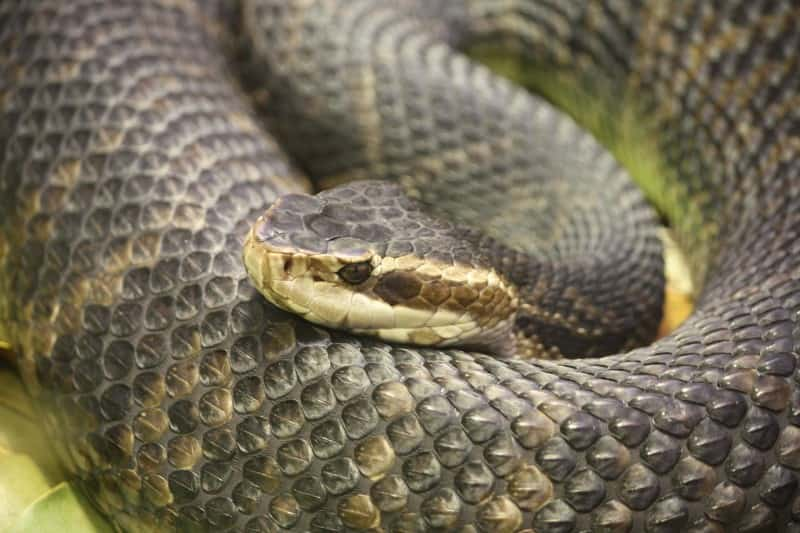
Also known as the water moccasin or water pitviper, the cottonmouth is the only semiaquatic viper in the world. This snake is a strong swimmer and can be found commonly across the Southeastern United States. It has been reported to be ocean-going as well, colonizing remote islands in the Gulf of Mexico.
The cottonmouth is one of the most feared venomous snakes in North America. Its powerful cytotoxic venom is so destructive that it can eat away flesh and result in grisly amputations. Their preference for hiding in water and attacking when least expected means that bites are also relatively frequent. Thankfully, modern CroFab antivenom keeps fatalities very low. In fact, cottonmouth venom is one of the main components of the treatment, along with venom from diamondback and Mojave rattlesnakes.
2. Timber rattlesnake (Crotalus horridus)
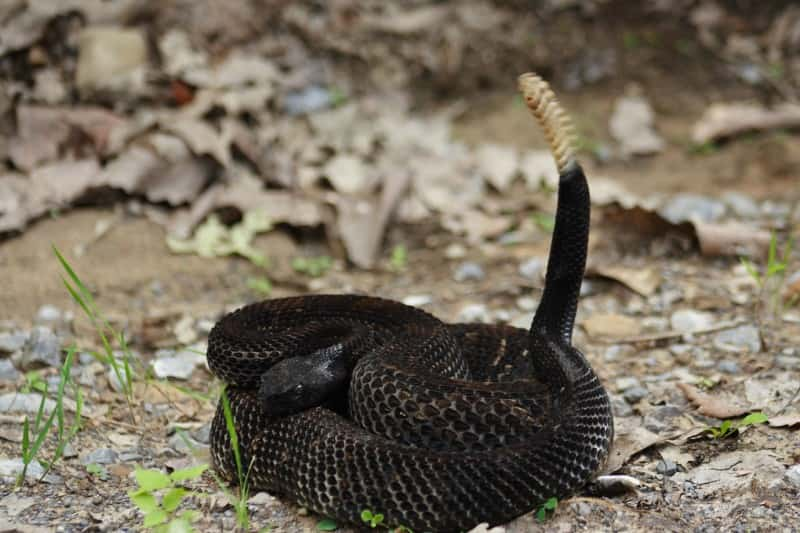
Timber rattlesnakes are dangerous on all fronts. They are large, have long fangs, and sport potent venom, which they can pump an alarming amount of into their prey at any one time. Thankfully for us though, they are also known for their mild temperament and characteristic rattle. Timber rattlesnakes are among the most patient of their kind and will often give lengthy warnings before attacking. Due to this, few fatalities have ever been reported.
3. Black diamond rattlesnake (Crotalus oreganus)
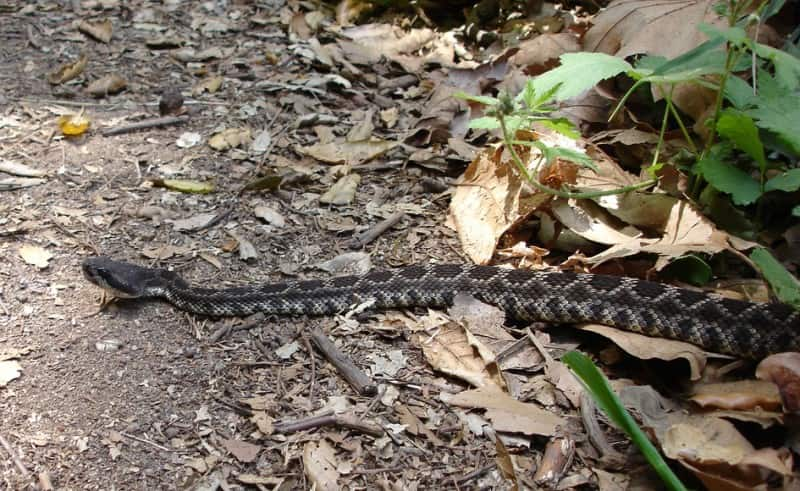
This dangerous rattlesnake boasts no fewer than seven different subspecies, some of which have the notable distinction of having a highly toxic venom that attacks nerve endings, requiring a much higher dose of antivenom to treat. They can be found widely across the western half of North America, from British Columbia to northern Mexico.
4. Tiger rattlesnake (Crotalus tigris)
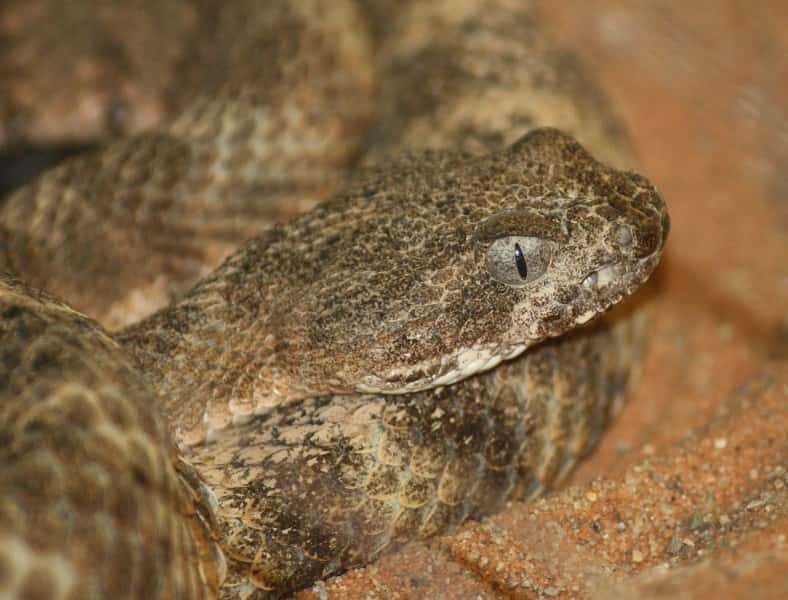
The tiger rattlesnake earned its fearsome name not for its behavior, but simply because of its pattern of vertical stripes. It also has the smallest head of any rattlesnake, but don’t let that fool you. This pit viper has an incredibly potent venom that by toxicity, is considered the most dangerous of all snakes in the Western Hemisphere. However, its small venom yield means that that there are much more dangerous snakes on this list.
The tiger only lives in a small area near the Arizona-Mexico border and few bites have been documented. The small amount of venom it injects per bite also means that fatalities are very rare.
5. Copperhead (Agkistrodon contortrix)
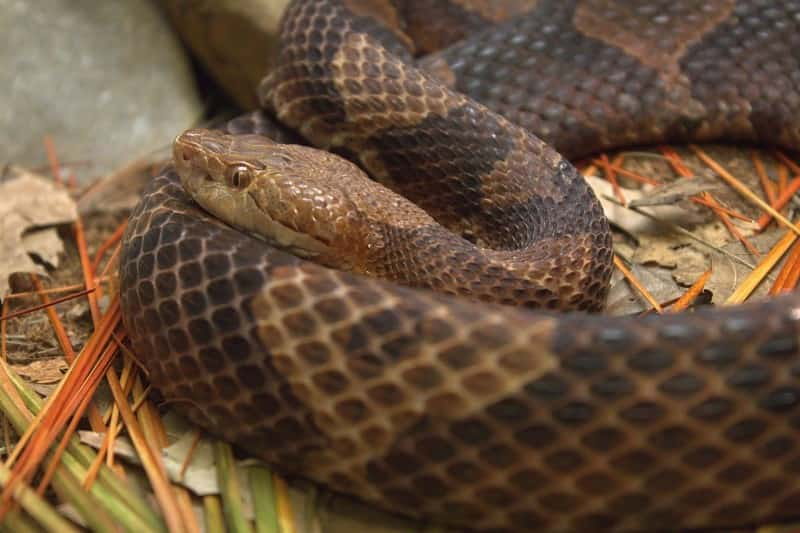
The copperhead is perhaps responsible for the most bites of any snake on this list. It’s not because the snake is inherently more aggressive, but because copperheads tend to “freeze” when met with approaching humans—instead of fleeing like most other, sensible snakes—and will bite when stepped on.
The copperhead also has what is believed to be the weakest venom potency of all pit vipers, which is a happy coincidence for the snake that is otherwise most likely to bite you.
6. Eastern coral snake (Micrurus fulvius)
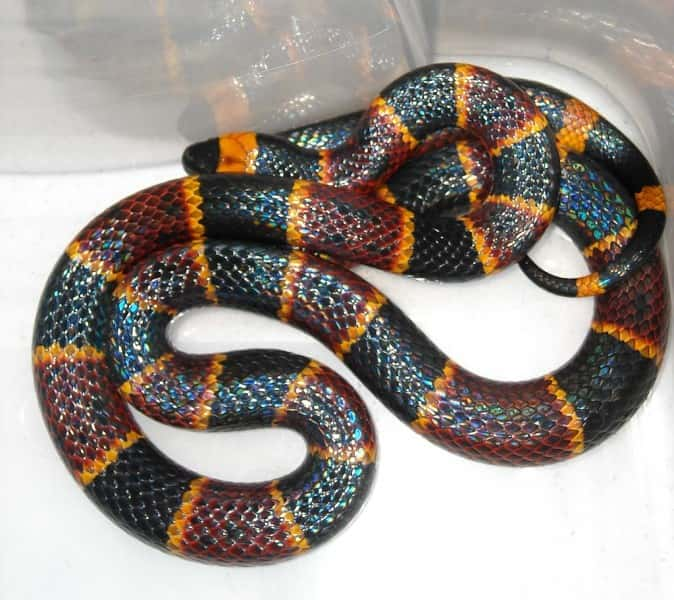
Eastern coral snakes are very reclusive and are rarely seen, which is great for hunters and hikers across the American Southeast. The eastern coral snake was once seen as the most dangerous snake in the region. While that reputation hasn’t exactly subsided, experts now say that fatalities from this dangerous species are actually very rare. This is thought to be because the coral snake has very little control of how much venom it can inject into a victim.
At any one time, a coral snake can hold enough venom to kill five people, yet in most defensive bites it only injects a minuscule amount. Still, a large enough dose can kill as early as within two hours, making this snake one of the deadliest on this list.
7. Western diamondback rattlesnake (Crotalus atrox)
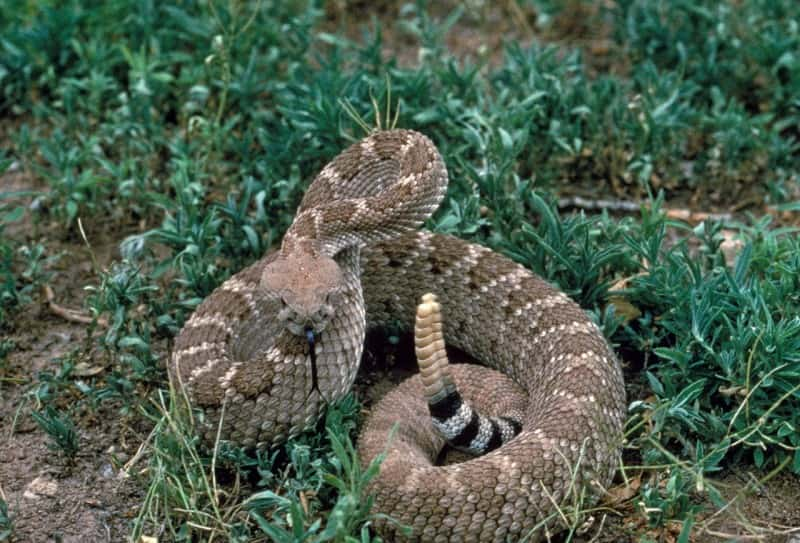
This snake’s method of venom delivery is perhaps the opposite of the tiger rattlesnake. The western diamondback has a relatively weak venom, but it can pump it out in high quantities, making it incredibly deadly. General symptoms include pain, heavy internal bleeding, swelling, muscle damage, and necrosis.
It is also single-handedly responsible for the most snake-related fatalities in Mexico, and only lost to its eastern cousin in the number of US deaths.
8. Eastern diamondback rattle snake (Crotalus adamanteus)
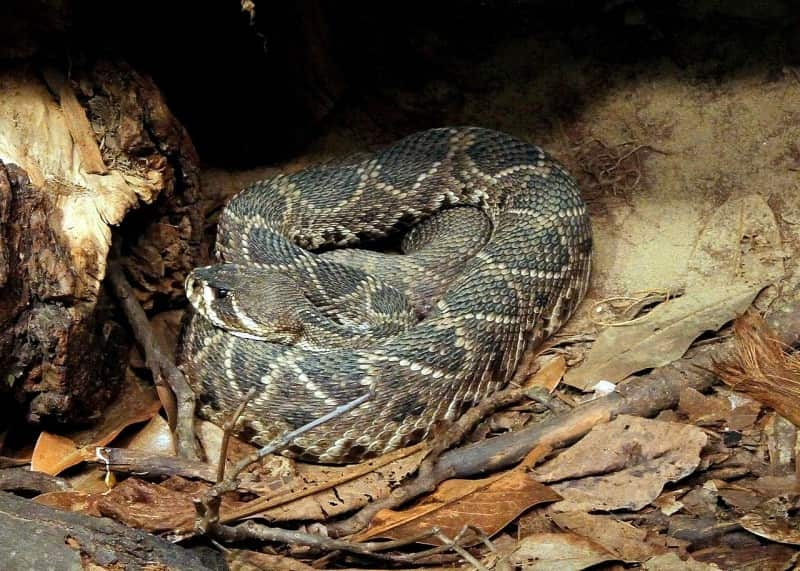
Indiana Jones may be the world’s most famous fictional archaeologist, but he’ll scream like a schoolgirl if he ever meets one of these. The eastern diamondback is the largest of all North American most venomous snakes, and it is arguably the most deadly. It has the largest fangs of any rattlesnake species in the world, a very high venom yield, and an absolutely devastating potency. The venom is so powerful, it can induce bleeding from the mouth and from the wound site.
A bite from this snake has a mortality rate as high as 30 percent.
9. Prairie rattlesnake (Crotalus viridis)
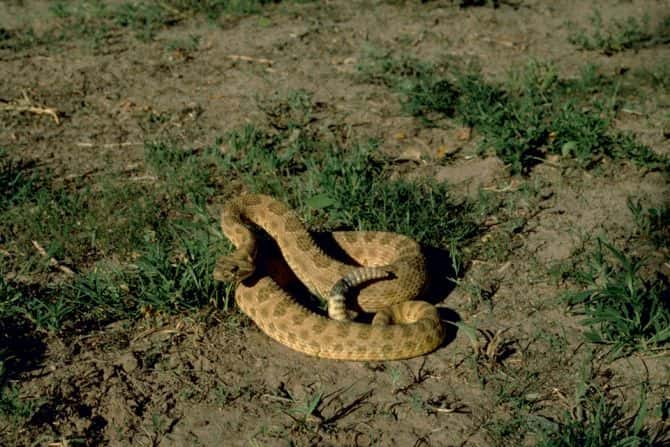
Compared to the two species that came before it and the one next up on this list, the prairie rattlesnake is practically harmless. Well, maybe not, but this rattlesnake is still responsible for far less deaths than its diamondback cousins. It can be found across the Western United States, southwestern Canada, and northern Mexico. Its venom contains potent neurotoxins as well.
10. Mojave rattlesnake (Crotalus scutulatus)
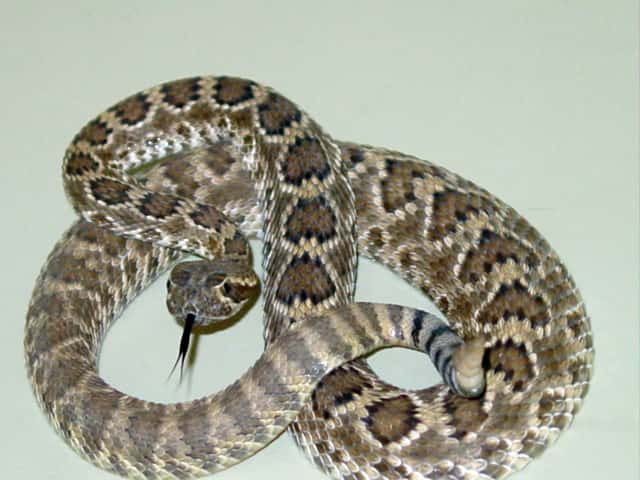
If you gauge deadliness by venom, this is one of the big boys. The venom of a Mojave rattlesnake is widely considered the most potent of all rattlesnakes, even surpassing that of the tiger rattlesnake. The bite does not at first appear to be especially worrying, due to delayed symptoms, but victims can eventually experience blurred vision and respiratory failure. Their venom is veritable cocktail of destructive enzymes and proteins designed to kill prey, which led to the Mojave rattlesnake’s now legendary reputation.
Needless to say, untreated bites are often fatal.


 The
The
The Timber Rattlesnake shown is somewhat deceptive , the snake miss only in the “dark” phase just before shedding I it’s skin. .It’s quite brightly colored with bright yellow markings after it sheds it’s old skin .The snake is at it’s most dangerous in the “dark” phase since their sight and their heat sensing “pits” become less acute just prior to shed and the snake is less likely evade before you get too close .
The Florida diamond back is a breed unto itself. They get quite large. But the biggest rattler I have ever seen was in south Florida and it was a diamond back with a distinctive brown coloration. This snake was large enough to be of considerable weight with its head being far larger than any man’s hand would ever be.
In the Ft. Lauderdale area there was a diamond back killed at 11 feet long with an 18 inch girth. It was in the suburbs living under an old tool shed. That was about 1961. The shed was knocked over by a tractor to clear the lot and that snake did not back up one inch. It wanted to stand its ground and fight the tractor.
All snakes have a purpose, but the triangle shape of the poison snake should be respected and given a wide girth when seen! 1992HDMD
I grew up with 2 of the deadliest snake species in the world in my backyard. Over the years we had many close shaves with, and lost one dog to snakes. We learned a lot of respect for the Brown snake and the Tiger snakes.
The Mojave rattler is a bad dude. I’ve shot one and lot of other snakes but who couldn’t with a shotgun?
saw a juvenile, copper-colored snake with cream underside (18″) in my peanut hay area in barn – 5th one in a few mos – diff kind, though, not sure what kind it was?
That was my trouser snake.
That was my trouser snake.
That was my trouser snake.
That was my trouser snake.
That was my trouser snake.
It may be a Rubber Boa. Very odd looking snake ann although not rare just rare to see. If I’m right they are harmless. Google them. I found one once.
Most venomous snakes are pit vipers. This is most easily recognized by the wide triangular head. If you kill a snake, and are not sure if it is a poisonous snake you can tell by the scales on the tail. On a poisonous snake the scales are small and over lap. On the non poinsonous snake the scales are one scale across with no division..
Or like you said if its venomous it will have an arrowhead shaped head….not triangle silly goose.
Interestingly you chose the “black phase ” of the Timber Rattlesnake . It is usually brighter colored with yellow markings , they are only as dark as the one shown when they’re about to shed and matured . During the last few days before shedding pit wipers get easily irritated because the have limited vision and the heat sensing pits are less acute .
In PA state we have Both Black phase and yellow Phase timber rattlers. . The color Does not Change, they are born that color stay that color for rest of their life. When they shed skin they may look a little off color or greyish color but their color still visible under skin that about to be shed. After black phase shed it skin, they look like black velvet! They are my favorite to see…. Yellows look nice too I’ve see bright yellows to bright olive coloring after they shed their skins…
The .410 makes the perfect little snake-charmer device ever!! Rattlers are good eats too.
There is a bit of misleading and alarmist BS here, which is to be expected when it comes to snakes. For example I have been around many, many hundreds of venomous snakes all of my life and never had one “attack” me. People like to believe they are much more fearsome than they really are.
They can be aggressive around reproductive times. They can also have a heightened sense of alarm when they’re shedding since they are blind. Most, though, only attacked when provoked.
The writer also gave some false info and left quite a bit out. If he really wanted to name The most poisonous snakes, he should have also included the sea snake. No anti venom and death in seconds
Don’t daydream, watch where you step and place your hands while in wooded areas, you don’t want to be surprised!
What about Sidewinders I heard they had some powerful venom.
A sidewinder I believe is the Mojave rattler. That is how they move, sideways.
They can move on sand better than other snakes.
I live in Maine. I have never heard of a venomous snake in the State. Can anyone tell me something different. If any ex ist I would imagine it to be the copperhead. In my 17 years here I am around a lot of hunters and old timer Mainers and none of them has ever heard of a venomous snake here. Would really like to know anything different. Thanks
There are none here in Maine, we have garter snakes and common green snakes. They are cool!
I looked it up and it said there are only 9 species of snake in Maine and none of them are venomous.
Also, though I don’t like snakes I have purposely missed them in my car when I saw them crossing the highway, particularly in the Southwest in NM, Arizone and Nevada. After heavy rains which are rare I would see a larger number of snakes on the highway. Since Vietnam I believe all creatures have a right to life. They are here for a purpose just like us. Sermon over,
Why there all creatures and all have a right to live and to put a face like that you can wanna make people upset it’s not right please be a little bit more mature and if your being serious please re consider there living beings too and if u kill kings snakes you’ll have more venomous snakes around your house (they eat venomous snakes)
Florida has a lot of these
There are no poisonous snakes in Maine and I am glad. Snakes are cool. Dont bother them, they wont bother you. Usually!
No such thing as a poisonous snake anywhere.
There actually is. It isn’t in the US, though. There is a snake which consumes poisonous frogs to get the frogs poison. This makes the snake poisonous.
There was a copper head in my army tent when I went camping I grabbed the knife and stabbed it in its head
OK….
especially if you want to see a dramatic rise in harmful rodents like mice, rats, gophers, etc. snakes keep rodent populations under control – so maybe you don’t want to kill them all.
texas has alot of rattlesnakes one time i shot him with a shotgun
Ps they said there’s at least 1 species of venomous snakes in every state except Alaska. I am not sure what venomous snakes in Maine but from the wording I think there is at least 1.
the timber rattlesnake
I have lived in Maine my whole life and there are no venomous snakes here.
Actually you missed the most dangerous of all… the one that does not rattle to warn, rather blithers after checking which way money and citizen wind blowing, then rather then biting at that stage is trolling for votes. Yep the ole “elected snake in or running for office, of any party”.. Can speak using venomous talk, bites after getting in office, and seems well protected by money… the most dangerous of all vipers as we never really know what they are up to doing, feed off money, have no ethics/morals as consider such a daily choice, and they do bite
Some Southern States have 3-4 of the Top 10 Deadliest Snakes.
Cottonmouths and Copperheads are more plentiful in my area.
The write should have said which state has the most deadly subspecies. There are actually 6 different type of Rattlers in Ga.
There are no snakes in Hawaii either (I hope!)
The write should have said which state has the most deadly subspecies. There are actually 6 different type of Rattlers in Ga. The writer also got it wrong why the low victims of Coral snakes. The Coral snake cannot strike. Those that are bit have been handling them. The coral snakes mouth is too small for strikes so it has to bite. I stopped reading after I this article after I saw the information was not complete and some were actually wrong
if you go back to the top it said that Arizona has 13 different types of Rattlers surpassing GA.
You might have 13 but none will do any type of harm. Nice try though.
There are no timber rattlesnakes in Maine, the state has NO venomous snakes! Period. New Hampshire has a couple small colonies of Timbers, and Vermont also has couple hundred or so, critically endangered in the Rutland area.
Hawaii does have some snakes. I’m pretty sure that most of them have been released from people who brought them onto the island from outside sources. But there are def a few snakes slithering around Oahu. I was stationed there for 3 years in the Army and every so often there would be a huge news story about another snake lol. Growing up in Oklahoma I’ve had more than enough experiences with copperheads and cottonmouths. The cottonmouth is a mean lil bugger. I can’t tell you how many ponds I’ve fished in seen water moccasins smashing out across the top of the water trying to chase me and my friends off.
Our fellow humans are far more aggressive and dangerous than any snake.